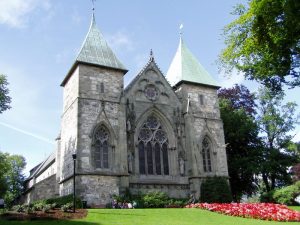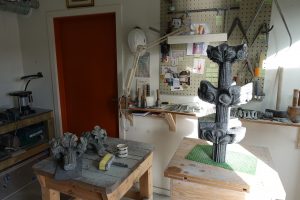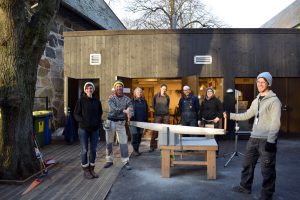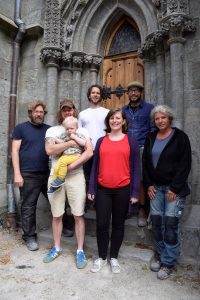Akira Inman recently graduated from our Diploma in Architectural Stone Carving course in June 2017. He has started working on a conservation project at Stavanger Domkirke in Norway, and here he writes about his experience of this fascinating programme. His account has also been printed in Forum, the journal of the Letter Exchange.
“I am very fortunate to be the first permanent stone carver on-site in a long-term conservation project on the 900-year-old cathedral, Stavanger Domkirke in the coastal city of Stavanger, Norway. Scheduled to be completed by 2025, it is commissioned by the Municipality of Stavanger with the Archeological Museum of Stavanger (University of Stavanger), my employers, who were awarded with the contract. The museum’s role is to restore and conserve all of the stone elements, both the exterior envelope and the building interior.

Cathedral of Stavanger, Norway. Own photography. {{cc-by-sa-2.5}}
Stavanger Cathedral, dated from 1125, is a Romanesque structure but was rebuilt and ‘modernised’ with a Gothic choir in the 1300’s after a fire in 1272. At the time of construction, Stavanger was a very small community with no history of erecting large stone structures: it is thought that the presiding bishop imported stonemasons from his hometown of Winchester. Perhaps through me they are following the tradition of hiring out some of the stonework to a non-Norwegian.
My background is in creative new-builds and heritage stone masonry, dry stone walling, and plaster conservation. Most recently I completed a three-year stone carving diploma program at City & Guilds of London Art School. While at C&G I was awarded the Idun Ravndal work/travel grant to Norway. This is how I met the Norwegian carving community and was introduced to two of their more well-known stone cathedrals; Nidaros Domkirke in Trondheim and Stavanger Domkirke. Both are undergoing significant restoration.
My responsibilities include carving stone mouldings and gothic ornamental carvings that have been included in the scope of the repair works. We are currently working on the East elevation of the building where most of the work involves correcting the previous restorations (1867, 1920, and 1984). As is often the case with ancient buildings that have evolved since their original construction, Stavanger Domkirke is a palimpsest of past architectural styles and conservation interventions: the cathedral displays a variety of techniques and approaches to conservation and the decorative arts. These past interventions, using modern materials such as ferrous dowels, cement and synthetic resins, are the direct causes of damage. Additionally the prosperous 19th century fish canning industry’s smoke from the smoking of the fish added to the air pollution, along with sea mist and the weather.
The cathedral is predominantly built with Gneiss, granite and greenschist but the east elevation, decorations, doorjambs and quoins are carved from soapstone (called kleberstein) which is quarried locally in Norway. The stone I am working with is the kleberstein: it is a dense, low porosity metamorphic with a high talc content making it soft and easily workable, at least when there are no inclusions of dolomite interfering with my chisel. It is also very resistant to heat – a valuable trait utilized from ancient times as cooking vessels and used for trade throughout the Viking and Medieval periods. Although there were many quarries available in the past, a significant proportion of them are now protected heritage sites; currently only one of them, Målselv, (also protected), supplies
carving-grade kleberstein to both Nidaros and our cathedral. Fortunately it possesses a large quantity of stone that has already been extracted and Nidaros’ workshop, being a larger operation than ours, can process the stones for us. With similar interests, conservation ethics and principles to Nidaros Domkirke we have been able to share knowledge and expertise along with our most basic natural resource.

Our approach to this project is not only to physically restore the domkirken but to encourage and preserve the traditional crafts and techniques required for authenticity in the process. In the case of Stavanger, all stone carving is by hand and we are using only lime-based mortars for our construction. In the past, considerable efforts were made on construction work for log houses and stave churches, through the Riksantikvaren (Directorate of Cultural History in Norway) Middle Ages Program and later through the Stavkirke (Stavechurch) program. For these decades-long initiatives, carpenters and joiners were trained in medieval craftsmanship and material understanding. A similar effort has not until now been seen for traditional masonry and stonework.
At Stavanger Domkirke, there is great care taken in the documentation of all aspects of this project and fortunately we have the capacity to save and store all the stones being replaced. It is too often the case that when a building is restored most of the stone elements removed are destroyed in the process, usually for budgetary or logistical constraints or both. In our case, the size of the cathedral and therefore the quantity of disturbed materials allows for a reasonably-sized safe space for storage for the benefit of future interests and investigations into our own historical moment in time, heritage and craftsmanship. Another unique aspect of this project is the use of the archaeological museum’s scientific resources to test materials in order to explore traditional techniques. Specifically,
the kleberstein used extensively in our cathedral is little known outside Norway and rarely used for carved ornament or masonry building. It is therefore something of a renewed field of study.


I work in a small and diverse team made up of fixer masons, conservators and researchers, all from different backgrounds, education and countries: four of whom are graduates of C&G. The size of the team facilitates a healthy sharing of knowledge. I am nowhere near fluent in speaking and reading Norwegian yet, but I look forward to learning more in order to delve into their literature and research surrounding Stavanger Domkirke and Norway’s heritage history.”


